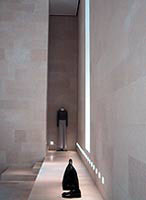On Display
Science Museum head of design Tim Molloy talks to Pamela Buxton about his views on the changing nature of museum display, and how retail systems are using similar methods to stimulate interest

Is there a relationship between designing for retail display and museum exhibitions? While the display systems differ, I think shops are becoming more like museums: they display things beautifully and are interested in the curated sell. Also, museums now recognise that they are just as much a part of the leisure/ entertainment experience as shopping. And like retail, we’re very careful about understanding our target audience, how we meet them and how we deal with what they want to know about.
Compared to retailers, we in the museums sector have been rather naive about marketing and branding in the past. Museums like the Guggenheim are showing that their brand is exportable. This lead is currently being developed in different ways by others in this sector.
Concept versus artefact
Designing exhibitions at the Science Museum is very different to anywhere else; key science themes aren’t always represented by iconic objects. A walk through the Making the Modern World gallery reveals that as we leave the 20th century, we can no longer rely on eloquent artefacts to represent developments in science and technology, which are changing at an ever-increasing rate.
Issues like Chaos Theory, the Human Genome project and the Big Bang all demand clear interpretation, but have few artefacts to illustrate them. Since we can’t rely on the ‘real thing’, we turn not only to interactivity, but also to artists, film-makers, writers, multimedia developers – frankly, anyone who might be able to assist in creating a well interpreted display. Who Am I?, the biomedical gallery in the Science Museum’s Wellcome Wing, is one of the best examples of this rich, layered approach to exhibition storytelling, with visitors spending up to one-and-a-half hours in the gallery, previously unheard of in the Science Museum.
Dialogue not monologue
A new relationship between museum and audience is demonstrated at the Wellcome Wing – gone is the passive monologue and in its place is interactive dialogue, encouraging and responding to visitor feedback. Since the new galleries focus on the now and the future rather than the history of science and technology, it has to be sure to reflect change. While all the galleries can be updated, the Antenna gallery, dealing with science in the news, really breaks new ground. It delivers changing displays every week rather than the six weeks it used to take to get new material on to the gallery floor. The gallery also interprets newsworthy science stories and presents temporary features on topics such as the male pill and cybercrime.
The vision for Antenna had more to do with the techniques of publishing rather than exhibition-making and I believe this is the beginning, rather than the end of a general trend in gallery display and design. Journalists and curators work with a specially-designed graphic language, state-of-the-art printing techniques and a coordinated system of display mechanisms offering objects, interactives, touch-screen databases and Internet links to create a 3D science magazine rather than a gallery. It is easy to imagine Antenna growing beyond London’s South Kensington and into shopping and leisure centres throughout the country.
Interactives
Interactivity is not for the faint-hearted. The development of successful interactives depends on many levels of curatorial scriptwriting, evaluation, prototyping, stress-testing and more evaluation before the brief is even handed over to a fabricator – anything less ends in failure.
Museum exhibition design is moving away from mechanical ‘so what’ interactivity towards more software-based systems involving carefully developed interfaces; less one-to-one and more social group activity across all age ranges.
You have to be very clear about what you want to say through interactives – could you instead be communicating it with labels, text, and what you can glean from an object? There is a knee-jerk reaction that says you must have interactivity in new galleries, but it’s important to first work out what you want to say and only then how best to say it.
Maintenance
There’s no such thing as a perfect gallery, even after researching prototypes and trialling the displays for robustness, ergonomics and safety. Things will break down – what’s important is how quickly you can repair them. Our performance target is to have 90 per cent of everything working. Nowadays we have a different sort of maintenance: ten years ago we’d employ more traditional engineers, now we’re employing software people. The Digitopolis gallery has been hard to develop and maintain because everything is electronic and at the weekend it gets hot and overloaded and things crash. But we’re persevering and improving software and interfaces constantly – ultimately, we will remove an exhibit rather than have it constantly causing problems.
Exhibitions of the future
Overall, I’m currently feeling that exhibitions as we define them aren’t the best way of getting things across. There’s a lot of detailed content required and I’d be interested in a different sort of space that doesn’t try to get over a lot of information – one that suggests ways of getting information through different layers. Something less that is immensely powerful and very simple rather than a complicated alternative.
In December, we go free and this will be a stimulus for change. I imagine museums could in the future focus on more temporary, nomadic, richly immersive exhibitions on grand, but popular themes, increasing outreach and promoting dialogue and feedback.
-
Post a comment



